#Robert Christian Anderson
Text
25 giugno … ricordiamo …
25 giugno … ricordiamo …
#semprevivineiricordi #nomidaricordare #personaggiimportanti #perfettamentechic
2019: Isabel Sarli, Hilda Isabel Gorrindo Sarli soprannominata Coca, è stata un’attrice e modella argentina. (n. 1935)
2017: Skip Homeier, attore statunitense. È stato accreditato anche con i nomi Skippy Homeier e Skip Homier. (n. 1930)
2017: Elsa Daniel, attrice argentina. Ha preso parte a circa trenta produzioni cinematografiche e televisive tra gli anni ’50 e gli anni ’80. Si è ritirata nel…

View On WordPress
#Barbara Dittus#Brenda Thompson#Coca#Elena Da Venezia#Elsa Daniel#Farrah Fawcett#Ferrah Leni#Hilda Isabel Gorrindo Sarli#Isabel Sarli#John P. John#John Pico Harberge#Jone Fortunata Carolina Cristina#Jone Frigerio#Michael Jackson#Mr. John#Patrick Macnee#Robert Anderson#Robert Christian Anderson#Shelby Grant#Skip Homeier#Skip Homier#Skippy Homeier#Ughetto Bertucci
0 notes
Photo


Films Watched in 2023:
04. The Pale Blue Eye (2022) - Dir. Scott Cooper
#The Pale Blue Eye#Scott Cooper#Christian Bale#Harry Melling#Toby Jones#Lucy Boynton#Gillian Anderson#Robert Duvall#Simon McBurney#Timothy Spall#Charlotte Gainsbourg#Harry Lawtey#Fred Hechinger#Joseph Brooks#Hadley Robinson#Edgar Allan Poe#Films Watched in 2023#My Edits#My Post
151 notes
·
View notes
Text
British men/women really got me in an unbreakable chokehold… and I’m ok with that… what do the say the first rule of addiction is admitting there’s a problem

#british men#andrew koji#andrew garfield#sam fender#joe quinn#joseph quinn#lewis hamilton#harry styles#emma corrin#josh o'connor#gillian anderson#naomi campbell#jodie turner smith#robert pattinson#jamie campbell bower#christian bale#tom hardy#daniel craig#lashana lynch#naomi harris#charlie hunman#will poulter#fabian frankel#rish shah
400 notes
·
View notes
Text


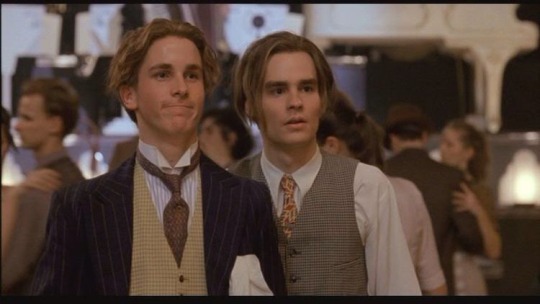
#swing boys movie#swing boys#christian bale#robert sean leonard#gay boys#these fucking guys#film#these two are as gay as neil perry and todd anderson#kinda gay#kinda depressing
11 notes
·
View notes
Text
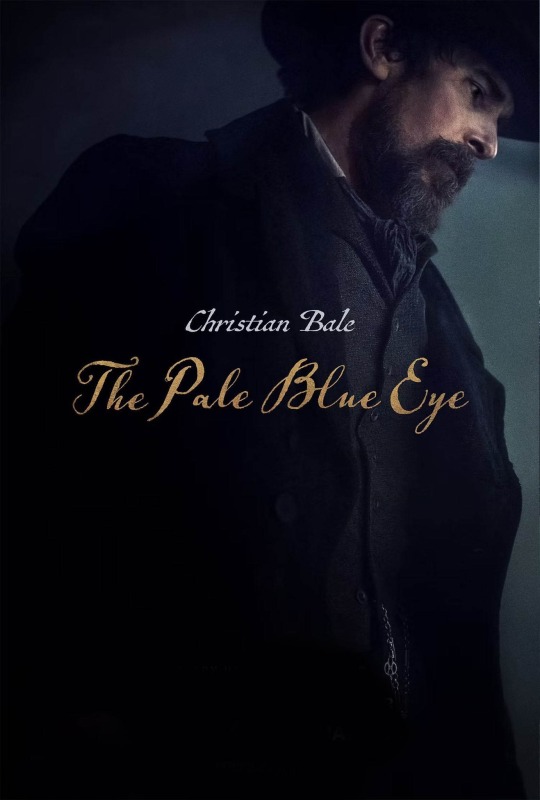
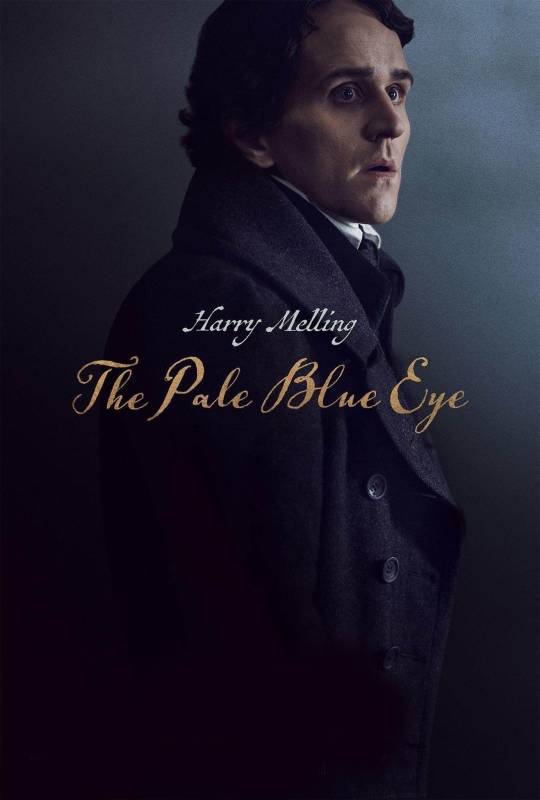
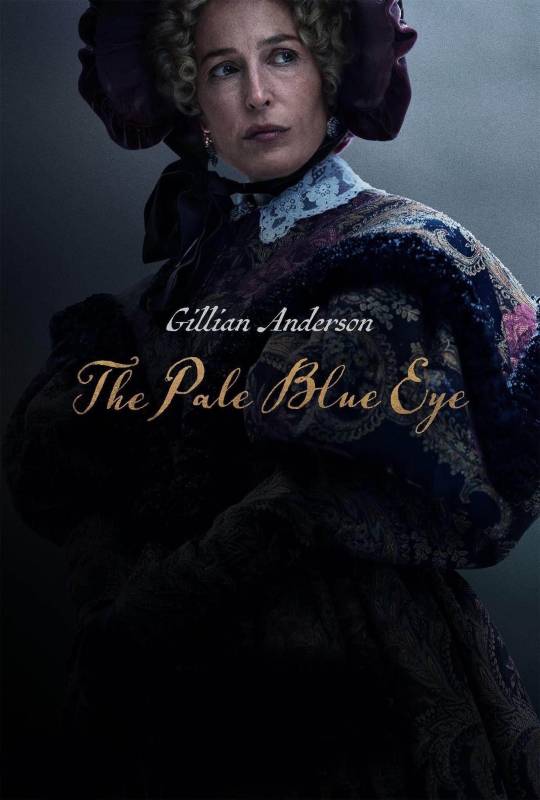



W A T C H I N G
#THE PALE BLUE EYE (2022)#CHRISTIAN BALE#HARRY MELLING#GILLIAN ANDERSON#CHARLOTTE GAINSBOURG#LUCY BOYNTON#ROBERT DUVALL#Toby Jones#Harry Lawtey#Simon McBurney#Timothy Spall#historical Fiction#mystery#thriller film#Edgar Allan Poe#west point academy#WATCHING#Crime film#occult#SCOTT COOPER
11 notes
·
View notes
Text
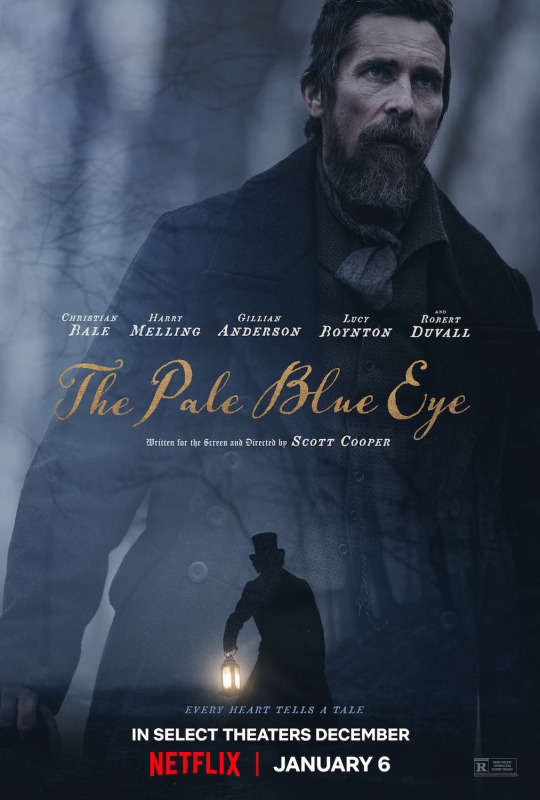
The Pale Blue Eye (Scott Cooper, 2022)
#the pale blue eye#scott cooper#christian bale#harry melling#gillian anderson#lucy boynton#robert duvall#film#posters
6 notes
·
View notes
Text
'In 2018, an interview with Oppenheimer director Christopher Nolan went viral — possibly because it was the first time he’d ever appeared relatable. In that conversation, he said his children sometimes jokingly call him Reynolds Woodcock, after the aloof, reserved protagonist of Paul Thomas Anderson’s Phantom Thread. Though Nolan’s scripts often feature signature, repeated (and often mocked) tropes, including time manipulation, dead spouses, and protagonists who face complex moral decisions, he injects very little of his own personality into his movies. Characters like Leonardo DiCaprio’s troubled team leader in Inception and Robert Pattinson’s equally troubled handler in Tenet are clearly styled after Nolan himself. But viewers rarely come away from Nolan movies with a greater understanding of his worldview, at least compared to the way directors like Martin Scorsese or Quentin Tarantino put their personalities on screen in every movie they make.
One underappreciated idea does recur over and over in Nolan’s work, though, and it surfaces again in Oppenheimer. The protagonists of many Nolan films become obsessed with a specific fear and go to great lengths to better understand or control their terror. In Nolan’s first blockbuster, Batman Begins, gangster Carmine Falcone (Tom Wilkinson) tells Bruce Wayne (Christian Bale), “You always fear what you don’t understand.” The quote acts as something of a guiding light not just for Bruce, but for Nolan’s back shelf of protagonists who seek a deeper knowledge of their phobias for the sake of control. In Oppenheimer, Nolan imprints this narrative device on a historical figure for the first time, and it feels like he’s being more open than ever about revealing what keeps him up at night.
There is no evidence that J. Robert Oppenheimer, the father of the atomic bomb, struggled with frightening visions of high-energy subatomic particles. This doesn’t come through in any documents about Oppenheimer the man, and Nolan seems to have added the idea to dramatize the film, as Oppenheimer periodically pauses to register and recoil from flashes of light, particles, and fire, all representing wordless fears he can’t explain. Though the movie’s dialogue never explicitly references these mysterious events, Nolan’s evocative imagery asks the audience to fill in the gaps themselves — are we seeing what’s in his mind, his future, or something else entirely?
Nolan’s Oppenheimer presents as an awkward, unsociable student with something off about him. It isn’t hard to imagine that he’s troubled by something. And what does this frightful student do? He dives deep into particle physics, devoting his life to understanding and attempting to control his fear — until it reaches critical mass.
The origin story in Batman Begins is the clearest example of this phenomenon: Batman’s vigilante persona was inspired by a traumatic childhood experience with bats. That plot point hews closely to Frank Miller and David Mazzucchelli’s classic 1987 comic arc Batman: Year One, but the film dives far deeper into Bruce’s fervent need to understand and control his terror. In a number of sequences featuring fear gas used by the movie’s villain, Scarecrow (played by Cillian Murphy, who also plays Nolan’s Oppenheimer), the filmmaker dips his toes into horror-inflected imagery. The Gothic architecture of Gotham combines with nightmarish sequences where villains see the superhero as a demonic monster, literalizing the metaphor of Bruce becoming his fear.
Following Batman Begins, Nolan’s Batman movies continue to dwell on this theme. Nolan assaults his protagonist with a series of villains who take on the shape of new nightmares. It’s as if he’s trying to teach Batman how to overcome the things he most dreads.
In addition to Bruce Wayne, the two protagonists Oppenheimer most resembles in this way are Leonardo DiCaprio’s Dom Cobb in Inception and Guy Pearce’s Leonard Shelby in Memento. The latter, Nolan’s mainstream breakthrough, focuses on a man with short-term memory loss who is so afraid of forgetting his purpose that he has it tattooed on his body. A significant portion of Inception takes place within Cobb’s dreams, which, through a very thinly veiled metaphor, are haunted by his wife Mal, played by Marion Cotillard. Guilt-ridden by the circumstances of her death, he subconsciously creates a murderous avatar in the shape of the shame he’s too afraid to face. He wrestles for control within his memory, attempting to hide her in a symbolic (and literal) basement in his mind. It doesn’t exactly work out.
Throughout Oppenheimer’s three-hour run time, Cillian Murphy’s protagonist struggles with existential horrors that are much larger than his personal regrets. In addition to the frightening visual bursts of atomic space, the film focuses most of its second-act tensions on the threat that the first atomic bomb test might ignite the hydrogen in Earth’s atmosphere. In real life, that threat was discussed and dismissed by the physicists at Los Alamos. But Nolan lingers on it, sending Oppenheimer to get the opinion of Albert Einstein, who acts as a sort of patron saint of science in the film. But Einstein provides no comforting answers, which ratchets up the tension and fear felt by characters and audience alike.
The threat of humans bringing about their own extinction is no new ground for Nolan’s films. And that may answer why, exactly, he’s so obsessed with fear and the war for control. In Interstellar, climate change devastates crops with a futuristic, dystopian blight. In his 2020 movie Tenet, an unseen society in the future attempts to reverse the flow of time to stop climate change before it gets out of hand. Between those two movies lies the World War II film Dunkirk, about the struggle for survival against a faceless threat. Though the Nazi presence implicitly hangs over the movie, Dunkirk doesn’t linger on a potential apocalypse in quite the same way as other Nolan movies. But the pervasive dread remains.
The fearsome final minutes of Oppenheimer drive this point home, as Nolan gives his protagonist a vision of a future devastated by nuclear apocalypse. His visions of dancing particles and flames give way to a clear, unambiguous doomsday — an uncountable number of rockets fire from an unknown country, streaking across the globe and detonating. Fire consumes everything.
Nolan’s devotion to the theme of people wrestling with their fears ties him to his protagonists, and his more recent focus specifically on humanity causing its own doom ramps that fear up to a universal level. It’s a heavy, existential worry, but it’s an illuminating glimpse into the mind of an artist who rarely lets the audience in. In his films, when a character obsesses about a topic, it typically means that’s the fear that keeps them up at night and drives them toward obsession as a means of control. Both Nolan and his iteration of J. Robert Oppenheimer are exposing their fears that humanity has the power to devastate life on Earth. And as climate change and political tensions simultaneously rise across the planet, it’s hard to blame him.'
#Christopher Nolan#Oppenheimer#Leonardo DiCaprio#Robert Pattinson#Paul Thomas Anderson#Phantom Thread#Tenet#Inception#Martin Scorses#Quentin Tarantino#Batman Begins#Tom Wilkinson#Christian Bale#Guy Pearce#Memento#Marion Cotillard#Albert Einstein#Los Alamos#Interstellar#Dunkirk
3 notes
·
View notes
Photo

Nick Anderson
* * * *
Moral hazards. September 19, 2022
Robert B. Hubbell
“Moral hazard” is an evocative phrase that recognizes the moral dimension of economic and political decisions. An easy example is Trump’s promise to pardon January 6th insurrectionists if he is elected as president in 2024. In that scenario, insurrectionists are encouraged to engage in more insurrection. Moreover, some voters are encouraged to support an aspiring dictator, which in turn encourages the aspiring dictator to take even more lawless positions. In that example of cascading hazards, Trump’s behavior seduces and corrupts people to support a dictatorial regime that is the antithesis of their native beliefs in law, order, and personal liberty.
Trump is a moral hazard to the Republican Party. In six years, he has convinced the party faithful to support and engage in increasingly corrupt, cruel, and reckless practices that undermine their morality and ethics—while posing a danger to our republic. Ron DeSantis’s callous abuse of refugees to make a political point (and gain a few votes) is an example of the GOP’s willingness to engage in increasingly cruel and reckless behavior to regain political control.
After the widespread condemnation of DeSantis, one would think that DeSantis would back off the offending behavior. On the contrary, DeSantis has followed Trump’s model by doubling down on the cruel behavior—because many Trump voters supported the heartless trafficking of refugees. See CBS Miami, More migrant flights likely; Gov. DeSantis: “The legislature gave me $12 million.”
Many commentators say that “The cruelty is the point.” What does that mean? It means that extremist Republicans take perverse glee in seeing the moral indignation of decent people shocked at the sight of gratuitous cruelty. They call it “Owning the libs”—an immature game that comes at a steep cost. By applauding political stunts that treat humans as stage props, extremist Republicans are debasing their humanity, morality, and decency. As Jennifer Rubin wrote over the weekend, “Republicans are wearing cruelty as a badge of honor.” That is the moral hazard of supporting Trump, DeSantis, and their acolytes.
The cost is particularly steep for those who—like DeSantis—somehow rationalize their cruelty in the name of Christianity. DeSantis has begun spouting the cri de guerre of Christian nationalism, i.e., “Put on the full armor of God,” and Trump has engineered a hostile takeover of large swaths of the evangelical Christian church.
The PEW Research Center recently released a report modeling the future of religion in America. The report's primary finding is that “[i]f recent trends in religious switching continue, Christians could make up less than half of the US population within a few decades.” Christians currently comprise 64% of the US population, a decrease from 90% in 1970.
It would be foolish to assert that the substantial decline in Christianity is caused by the increasing political activism in the church. But it would also be foolish to pretend that the increasing political activism of the Christian church is unrelated to its rapid decline in America. When “going to church” feels like “going to a political rally,” the obvious question arises: Why not just go to the political rally?
The current hatred of immigrants by Christian nationalists hollows the soul of an institution that has welcomed and cared for immigrants since its founding, e.g., the Nativity Narrative and the parable of the Good Samaritan. It is too much to expect that Christian nationalists will recognize their hypocrisy. But it is not too much to expect that other Christians will condemn those who have perverted a founding principle of the Christian church. Until the voices of Christian charity and love drown out the hate-filled rhetoric of Christian nationalism, it is up to the media and concerned Americans to highlight the hypocrisy and cruelty of the Republican Party.
And as Christian nationalists follow Trump over a moral precipice, he may be leading them to a freshly minted circle of hell. Trump is now using QAnon imagery and slogans at his rallies. See APNews, Trump openly embraces, amplifies QAnon conspiracy theories. Will Christian evangelicals follow Trump as he promotes a fringe conspiracy theory with religious overtones, e.g., an apocalyptic “Storm” that will end the reign of Satan-worshipping pedophiles? They already are. See CNN, How QAnon uses religion to lure unsuspecting Christians. Such is the moral hazard of supporting and excusing Trump’s politics of hate and cruelty. After a while, nothing seems too outrageous or hateful to believe.
Finally, DeSantis’s effort to engage in human trafficking poses a legal hazard to DeSantis. He is currently unconcerned, but when Ted Cruz says that a fellow Republican is engaged in illegal behavior, you should worry. See The Independent, Ted Cruz forced to admit trafficking migrants to Martha’s Vineyard is illegal in Sean Hannity interview. An attorney for thirty of the refugees trafficked by DeSantis is demanding a DOJ investigation. See The Independent, Migrants’ lawyers call for criminal investigation into DeSantis’ Martha’s Vineyard stunt.
And while the political fallout may be the least important consideration, Spanish-language radio stations in Florida were harshly critical of DeSantis’s virtual kidnapping of the Venezuelan refugees. See Politico, ‘Huge mistake’: DeSantis’ migrant transports could undercut support in South Florida. As noted in Politico,
“Florida Republicans in recent years have made it a priority to court Venezuelan Americans, many of whom fled their home country in the past decade amid the political and economic turmoil under Nicolás Maduro and his predecessor Hugo Chávez. It’s a story that has parallels to Cuban Americans — a crucial bloc of support for the GOP — who left their country to escape communism.”
#Nick Anderson#political cartoon#removing the problem#DeSantis#Authoritarianism#cruelty#Robert B. Hubbel Newsletter#Robert B. Hubbell#Christianity#A Moral Hazard
14 notes
·
View notes
Text


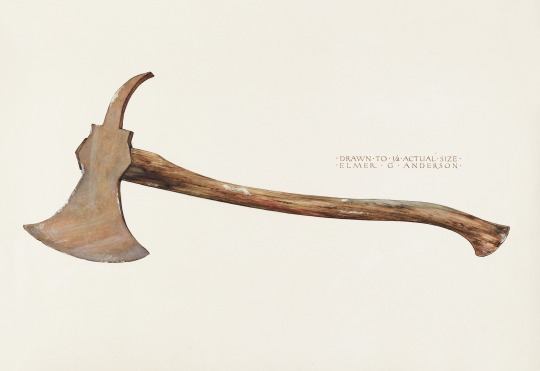
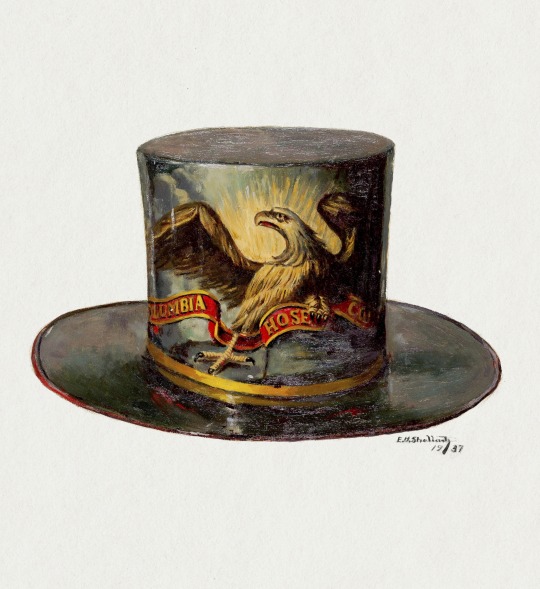




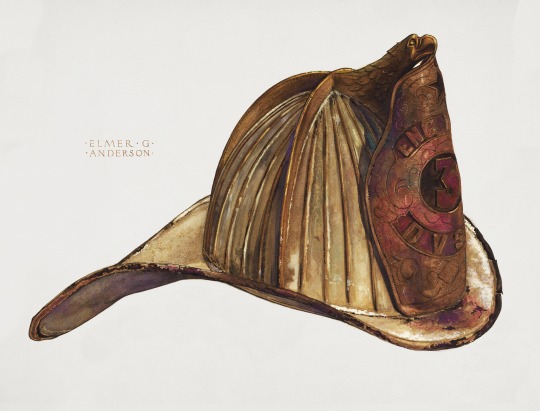

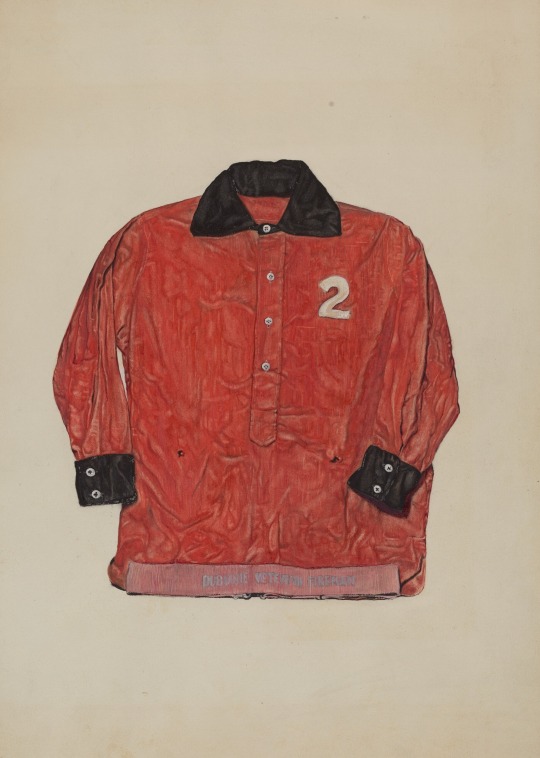
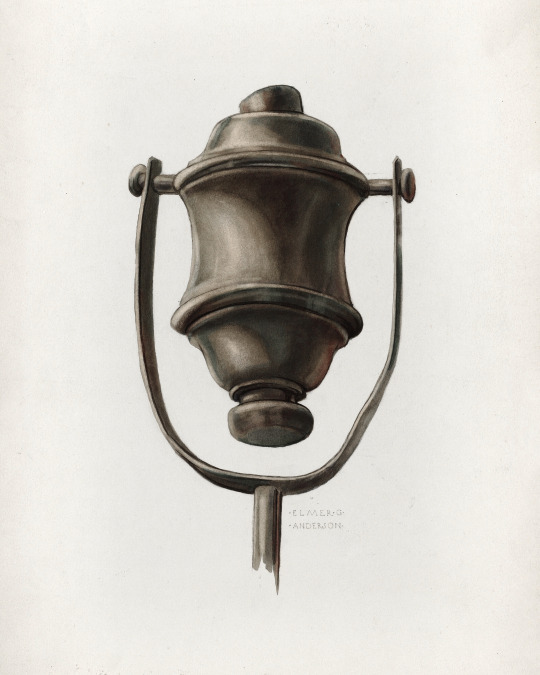



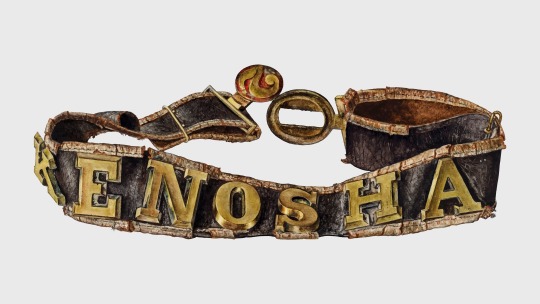
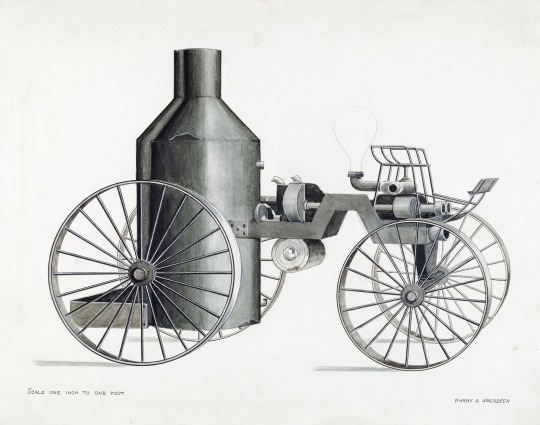

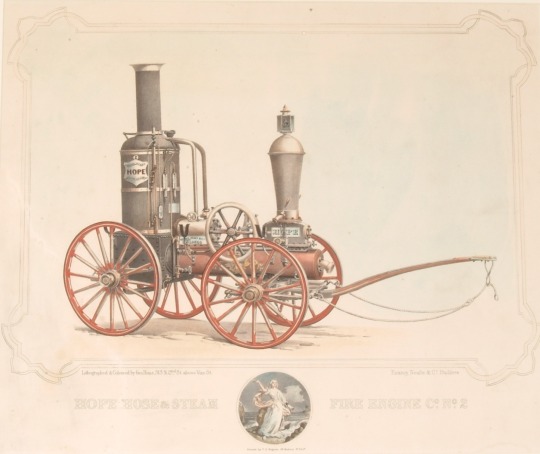

Illustrations of firefighter uniforms, tools, & fire engines {1774 - 1936}
#lithograph#vintage illustration#firemen#fire fighter illustrations#fireman uniform#vintage fireman uniform#1700s#1800s#1900s#fireman tools#Prosper Desobry#lithographers#Christian Francis Rosborg#Elmer G. Anderson#George Bobholz#Eugene Shellady#William Lang#Robert Tardiff#Page Coffman#Eugene Bartz#Alfonso Moreno#Robert Gilson#1937 fireman uniform#Hans Mangelsdorf#fire pump#hand powered fire pump
4 notes
·
View notes
Text
The Pale Blue Eye (2022, dir. Scott Cooper) - review by Rookie-Critic
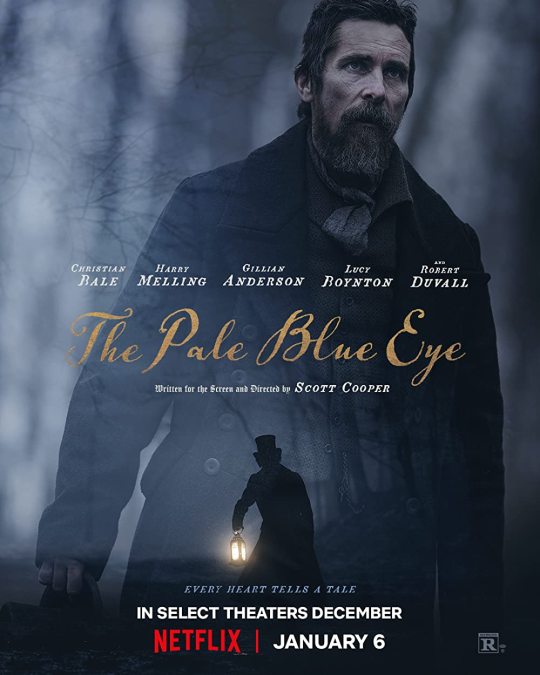
The Pale Blue Eye sees Christian Bale giving a masterclass in acting in a movie that, otherwise, is just fine. I'm big fan of writer/director Scott Cooper, having seen and loved 2 of his earlier films, Out of the Furnace and Crazy Heart, but his last couple of films, while not bad, necessarily, have been disappointing. His last film, Antlers, felt content to idle its way through its story until it just, kind of, ends; never seeking to dive too deep into any of its very interesting characters enough to develop any true impact on the audience. The Pale Blue Eye also has this issue. A lot of the film isn't terribly interesting. That's not to say that the central mystery isn't interesting, because it very much is, which makes it all the more surprising that none of the investigation or surrounding story was very awe-inspiring or gripping. It had its moments of "oohs" and "aahs," but they were fleeting. I was concerned with how the story would resolve itself, but never too concerned to be more than passively invested. I will say the sets and production design of the film are top notch, and for a period piece (which I confess aren't necessarily always my cup of tea) I found the movie very visually engaging when the script and storytelling were lacking. The story also suffers from from a structuring problem. It feels terribly disjointed, and again, that meandering pace makes it feel like it drags in certain areas, but the biggest confusion comes in the form a very unexpected fourth act.
Our mystery gets solved at about the 90-minute mark. The whodunnit is resolved and we reach what anyone would conceivably call a final scene. Then the film decides that no, it's not over, but in fact still has 38 minutes left of its runtime. It's jarring at first; you really are stuck thinking "what could we possibly be using 38 more minutes for? Is this really necessary?" While I do think the movie's true finale feels a little out of place with the rest of the film, and the buildup to this moment is almost non-existent, I have to say that is also, by far, the best section of the entire film. The absolutely legendary performances given by both Christian Bale and Harry Melling (who is playing a very young, very green, and very Virginian Edgar Allan Poe) in this final sequence is genuinely more awe-inspiring than the entire rest of this movie and all of Antlers put together. Bale is in peak form, and every inch of his face is crawling with anger, remorse, regret, sorrow, and maybe even gratitude. Melling gives an incredible monologue and proves himself capable of keeping up with Bale, and the fact that Melling is taking up so much of the linguistic space of the scene makes Bale's performance even more impressive because he is somehow still the center of your attention, without even saying much for a lot of that final bit. There's one shot in particular (keeping it spoiler-free here) where the camera just lingers for close to 10 seconds on Bale's face as he looks forward past the camera, and his expression grows from complete disbelief slowly to sorrowful acceptance. I've had this issue with the last few movies I've seen of Bale's. He was practically the only good thing of note in Thor: Love and Thunder, and he was also the clear standout of Amsterdam, a movie that I would describe as "good, but not great." I love that he is the kind of actor that, no matter what he's in, he is going to crush it. I know I'm in safe hands with Bale even if the film itself is lacking, but I hope that soon he starts to fight in his own weight class again, because Christian Bale with a solid script is honestly something truly wondrous.
As it stands for this movie and its script, I'd say that The Pale Blue Eye is perfectly serviceable, but flawed, even without that final sequence. However, if the entire film had been as riveting as that fourth act, this may have been an easy 10, but I can't justifiably give it an amazing score like that based purely off of one sequence. Instead, I'll settle on a score of "could have been better" and patiently away Cooper's next film in hopes that it is as good as I know he is capable of.
Score: 7/10
Currently streaming on Netflix.
#The Pale Blue Eye#Scott Cooper#Christian Bale#Harry Melling#Lucy Boynton#Toby Jones#Gillian Anderson#Harry Lawtey#Timothy Spall#Simon McBurney#Charlotte Gainsbourg#Robert Duvall#Hadley Robinson#Fred Hechinger#Joey Brooks#Brennan Keel Cook#Steven Maier#Charlie Tahan#Gideon Glick#film review#movie review#2022 films
2 notes
·
View notes
Text
The dark, gritty Murder/Mystery/Thriller is a slow burner... but the stellar cast, amazing acting and the build up throughout kept me interested.
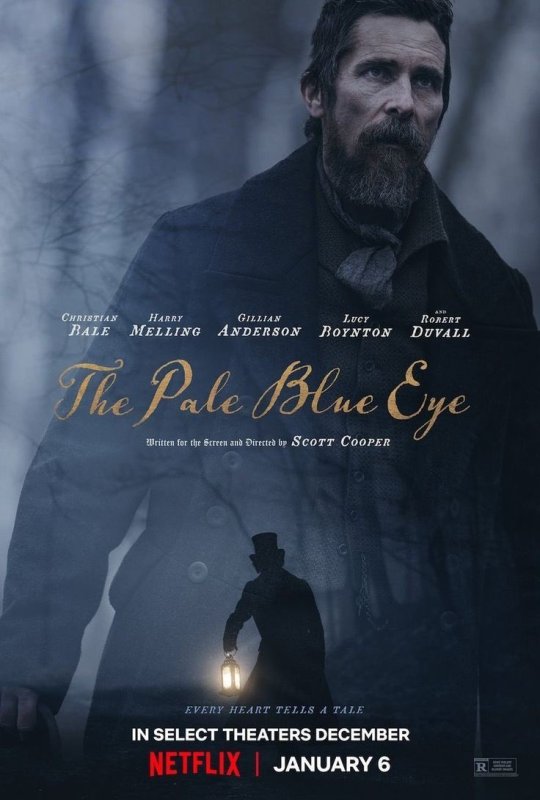
#the pale blue eye#crime movies#murder mystery#mystery movies#thriller movies#christian bale#harry melling#gillian anderson#toby jones#robert duvall#timothy spall#charlotte gainsbourg#lucy boynton#harry lawtey#netflix movie#netflix#netflix and chill#netflix and alone#movie#movie night#movie nerd#movie review#movie poster
2 notes
·
View notes
Photo
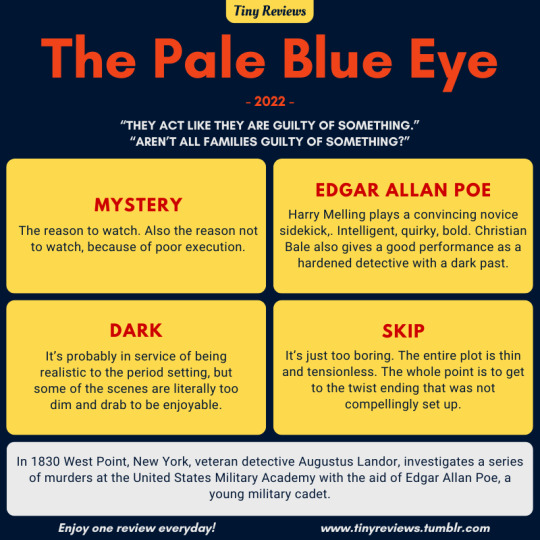
Great performances by Christian Bale and Harry Melling. But the plot falls short.
The Pale Blue Eye is a 2022 American mystery thriller film written and directed by Scott Cooper, adapted from the 2003 novel of the same name by Louis Bayard. It features an ensemble cast including Christian Bale and Harry Melling as Landor and Poe, with Gillian Anderson, Lucy Boynton, Charlotte Gainsbourg, Toby Jones, Harry Lawtey, Simon McBurney, Timothy Spall and Robert Duvall.
#the pale blue eye#christian bale#harry melling#gillian anderson#lucy boynton#charlotte gainsbourg#toby jones#harry lawtey#simon mcburney#timothy spall#robert duvall#edgar allan poe#augustus landor#mystery thriller#movie review#2022
3 notes
·
View notes
Text
Official Teaser Trailer For THE PALE BLUE EYES Starring Christian Bale
Official Teaser Trailer For THE PALE BLUE EYES Starring Christian Bale
Netflix has released this official teaser trailer for THE PALE BLUE EYES movie starring Oscar winner Christian Bale.
On Netflix January 6, 2023 In Select Theaters December 23, 2022
Written & Directed By Scott Cooper
Based on the book by Louis Bayard
Produced by Scott Cooper, Christian Bale, Tyler Thompson, John Lesher
Executive Producers Tracey Landon, Dylan Weathered, Louis Bayard, Chris…

View On WordPress
#Brennan Cook#Charlie Tahan#Charlotte Gainsbourg#Christian Bale#Fred Hechinger#Gideon Glick#Gillian Anderson#Hadley Robinson#Harry Lawtey#Harry Melling#Jack Irving#Joey Brooks#Lucy Boynton#Matt Helm#Robert Duvall#Simon McBurney#Steven Maier#The Pale Blue Eyes#Timothy Spall#Toby Jones
2 notes
·
View notes
Text
Corazón que late, corazón que delata… “Los Crímenes De La Academia”

West Point, 1830. Encuentran muerto a un cadete en una madrugada de invierno. Pero cuando el cuerpo llega a la morgue, la tragedia se convierte en un acto de crueldad: el corazón del joven fue extirpado.
Los líderes de la emergente academia militar, por miedo a terminar perjudicados, recurren al detective Augustus Landor para resolver el asesinato. Pero el código de silencio de estos estudiantes obstaculiza su investigación, por lo que recluta a uno de los muchachos para ayudarlo a resolver el caso, un cadete excéntrico que detesta el rigor del ejército y tiene afición por la poesía, un joven llamado Edgar Allan Poe.
Estreno: 6 de enero de 2023 en Netflix.
youtube
La película está dirigida por Scott Cooper y cuenta con las actuaciones de Christian Bale, Harry Melling, Gillian Anderson, Lucy Boynton, Charlotte Gainsbourg, Toby Jones, Simon McBurney, Hadley Robinson, Timothy Spall, Robert Duvall, Harry Lawtey, entre otros.


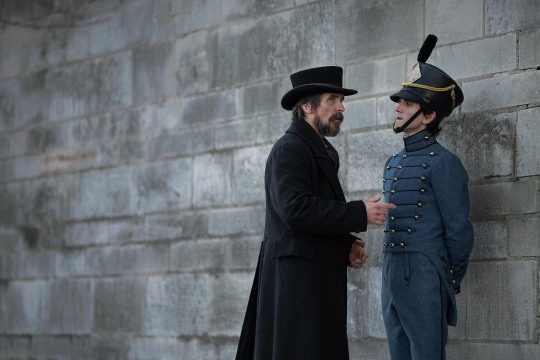
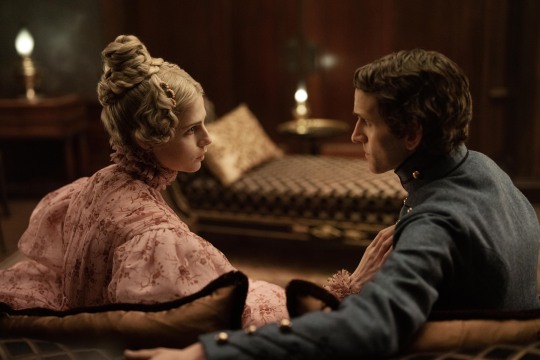

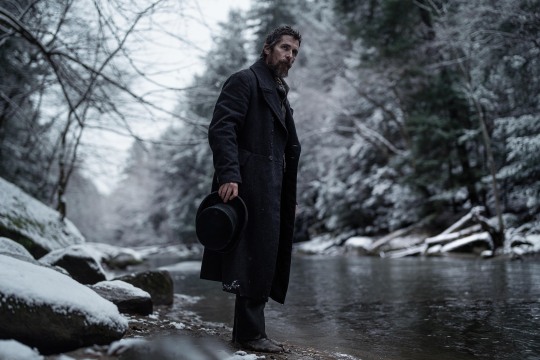

#Los Crímenes De La Academia#Christian Bale#Harry Melling#Gillian Anderson#Lucy Boynton#Charlotte Gainsbourg#Toby Jones#Simon McBurney#Hadley Robinson#Timothy Spall#Robert Duvall#Harry Lawtey#Películas#Netflix
0 notes
Text
Κριτική Ταινίας : The Pale Blue Eye
Κριτική Ταινίας : The Pale Blue Eye του Scott Cooper #review
Με τους Christian Bale, Harry Melling, Gillian Anderson, Lucy Boynton και Robert Duvall
Το The Pale Blue Eye του Scott Cooper είναι ένα αργό, βαρύ δράμα με γοτθικό ύφος, και πολλές ανατροπές.
Ένας συνταξιούχος ντετέκτιβ προσλαμβάνει τον έξυπνο δόκιμο της στρατιωτικής ακαδημίας Ουέστ Πόιντ, Έντγκαρ Άλαν Πόε, για να εξιχνιάσει έναν φόνο στη Στρατιωτική Ακαδημία.
Ο ρυθμός είναι πολύ αργός και, κάποιες φορές, η ταινία χάνει την εστίασή της. Οπτικά είναι εντυπωσιακή, με εξαιρετικά…
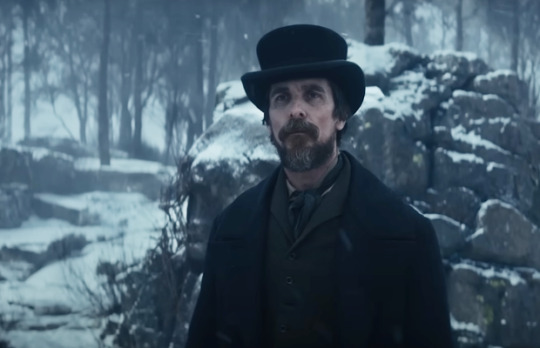
View On WordPress
#Christian Bale#Gillian Anderson#Harry Melling#Lucy Boynton#review#Robert Duvall#Κριτικές#Κριτικές Ταινιών#ΚΡΙΤΙΚΗ#Κριτική Ταινίας
0 notes